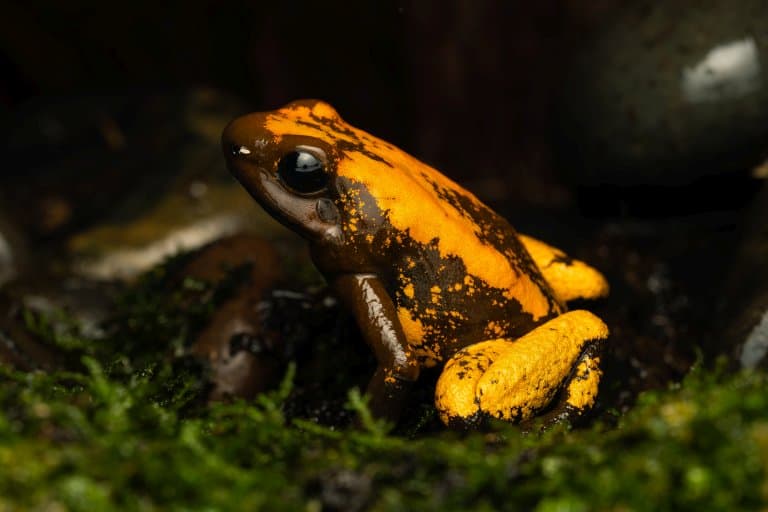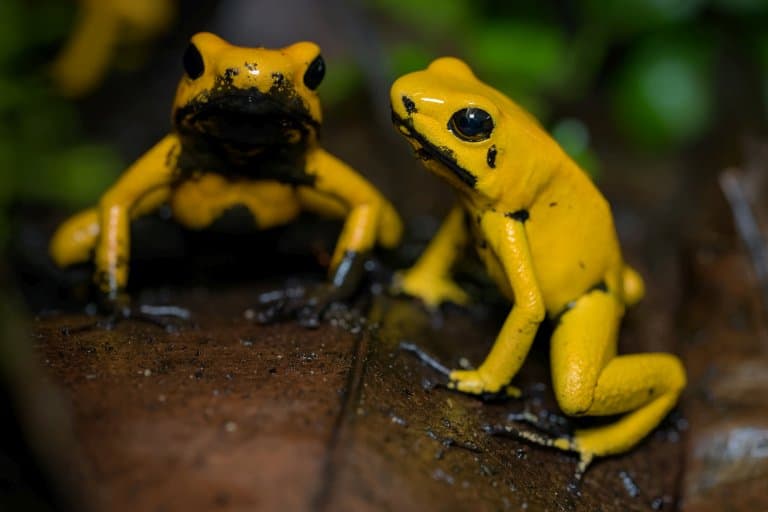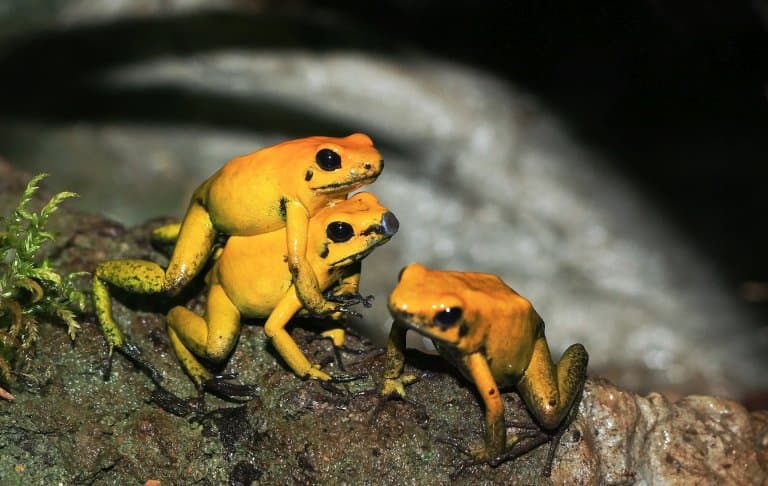Golden Poison Frog Profile
In the darkest Colombian rainforests sit a tiny killer.
This discreet, unassuming little amphibian might be one of the most toxic animals on earth, and, like a billionaire in a jumper, hides its power behind a plain façade.
The golden poison frog also known as the golden dart frog, or golden poison arrow frog, is a species of poison dart frog, and the most poisonous frog in the world.

Golden Poison Frog Facts Overview
| Habitat: | In the leaf litter of forests and wetlands |
| Location: | Colombia |
| Lifespan: | 10 to 20 years in captivity |
| Size: | Up to 4cm (1.6 inches) long |
| Weight: | 25g (0.8oz) |
| Colour: | Varied: green, through to yellow, golden and orange, even turquoise |
| Diet: | Ants, beetles and mites |
| Predators: | Fire-bellied snake |
| Top Speed: | Slow |
| No. of Species: | 1 |
| Conservation Status: | Endangered (IUCN) |
Found on the Pacific coast of Colombia, these fearsome frogs consume a diet composed of flies, crickets, ants, and beetles. They absorb plant poisons that are carried by their prey.
The golden poison frog is said to have enough poison to kill over ten people.
Despite this, they’re in tremendous danger, on account of their limited habitat being threatened by destructive human activities.
To the locals, they’re well known for providing posion for blowdarts.
A poison that can rapidly paralyse monkeys and other jungle game, as well as the unlucky hunter who pricks his finger on a dart.
Interesting Golden Poison Frog Facts
1. Unassuming little frogs
These tiny amphibians are not as brightly coloured as many of their close relatives. Even their sister species, P. bicolor, has a contrasting pattern.
The golden poison frog is monochrome and sits proudly among the leaf litter of the wetlands and forests in its endemic regions of Colombia.
Adults are typically bright gold-yellow in color, while juveniles are black which fades as they mature. They can also occur in other morph colors, including mint green.

2. They’re small, but large for their family
Despite only measuring up to 6cm and weighing around 30 grams, golden poison frogs are the largest species of the poison dart frog family – which are all typically minature in size.
Females are typically larger than males.
3. Sirens of the forest
Even their call is nothing to get worked up about. The male puffs out his little air sac under the chin and resonates a melodious trill that echoes relaxingly through the forest.
Like the colouration of the skin, the sound this species makes is benign, even pleasant to witness. But this call obscures a very dangerous potential. 1 2
4. They have a potent neurotoxin
As you might have gathered from the name, these frogs are covered in Batrachotoxin, a potent poison, named after the frogs that possess it. To understand how this toxin is so effective, it’s useful to understand how muscles work.
After eating, the salt from your chips gets dissolved into your body’s water supply and sodium atoms separate from the chlorine ones. These positive sodium ions are then allowed into cells through sodium channels, which open up to let them through.
This transit through the membrane flips the electrical charge across it, and in muscles, a Mexican wave occurs in less than a millisecond, sending an action potential of electricity along the tissues and contracting the fibres. Almost immediately after this, this charge is reset as potassium ions leave through their own channels so the cell can fire again.
This sudden reversal of charge is the essence of every muscular motion in the body, and it’s how the golden frog’s poison is so effective.
Batrachotoxin puts a stop to this whole process very rapidly, by essentially holding the sodium channels open. It permanently binds to these channels and sodium floods into the cell, preventing them from resetting their charge. The diaphragm and heart, along with all other muscles, stop working, and victims quickly perish!
5. They get it from beetles
There are only a handful of animals in the world that have this toxin. Surprisingly, one of them is a bird: the Hooded Pitohui.
But these frogs are too small to eat a bird this size; they get their power from Melyrid beetles, which they eat in large numbers. Instead of succumbing to the beetle’s toxins, the frogs concentrate and store them to secrete them in deadly amounts on their skins.
But it’s the dose that makes the poison.

6. And these frogs have it in buckets
Poisons like this are only as dangerous as the amount that’s administered. But this is of no concern to the golden poison frog since it has plenty to spare.
The golden poison frog is considered by many to be, not only the most poisonous frog, but the one of the most toxic animals on earth.
It’s estimated that the human lethal dose of this Batrachotoxin is between 2 and three micrograms per kilo of body weight if absorbed through under skin.
A wild-caught P. terriblis may contain anywhere up to around 2,000 micrograms, so even if you’re a robust 150kg, it has enough to kill you 13 times over. This frog is around 20 times more toxic than other members of its genus.
Oh, and there’s no antidote known. So, how can such a dangerous animal be so endangered? 3
7. They have one known predator
The appropriately-named fire-bellied snake is one of the only animals known that can comfortably hold one of these frogs in its body.
Through mechanisms apparently unknown, it seems to be immune to the toxins secreted by dendrobatid frogs like this one and the poison dart frogs.
But this snake isn’t what’s harming the species’ population count.
8. They’re threatened by illegal logging
This species exists only in a handful of small areas in Colombia. As an endemic species, it exists nowhere else in the wild, making it vulnerable to extinction if the areas it relies on are under threat.
And sadly, they are. Habitat loss due to illegal logging, mining operations and (ironically) toxins from illegal spraying of crops are all major threats to the species, and as such, their numbers are in decline.
They’re currently listed as endangered as a result and in dire need of protected areas to reproduce. 4
9. Breeding is a team effort
And this is a pity because these small frogs put a lot of effort into their offspring. At least, for amphibians.
After mating, the female lays eggs on the ground, rather than in the water. These eggs are cared for by the male, who transports the newly hatched larva to their nursery pools.
With this amount of care, it’s hopeful that the unique and endemic golden poison frog could easily make a recovery if given enough space.

10. They’re important to indigenous people
When hunting, the Emberá and Cofán people of Colombia’s rainforest utilise frog poison in their darts.
To extract the poison, they gently expose the frog to the heat of fire, which causes the frogs to release minute amounts of deadly fluid.
Arrow heads that have been immersed in the fluid can be lethal for up to two years!

Golden Poison Frog Fact-File Summary
Scientific Classification
| Kingdom: | Animalia |
| Phylum: | Chordata |
| Class: | Amphibia |
| Order: | Anura |
| Family: | Dendrobatidae |
| Genus: | Phyllobates |
| Species: | Phyllobates Terribilis |
Fact Sources & References
- Troy Goldberg’s Tropical Garage (2021), “Pyllobates Terribilis Mint Calling”, YouTube.
- Nowacki, A.M (2012), “AMPHIBIA: ANURA: DENDROBATIDAE”, Repositories Library.
- Myers, Charles W. (1978), “A dangerously toxic new frog (Phyllobates) used by Emberá Indians of western Colombia, with discussion of blowgun fabrication and dart poisoning.”, American Museum of National History.
- “Golden Poison Frog”, IUCN Red List.
